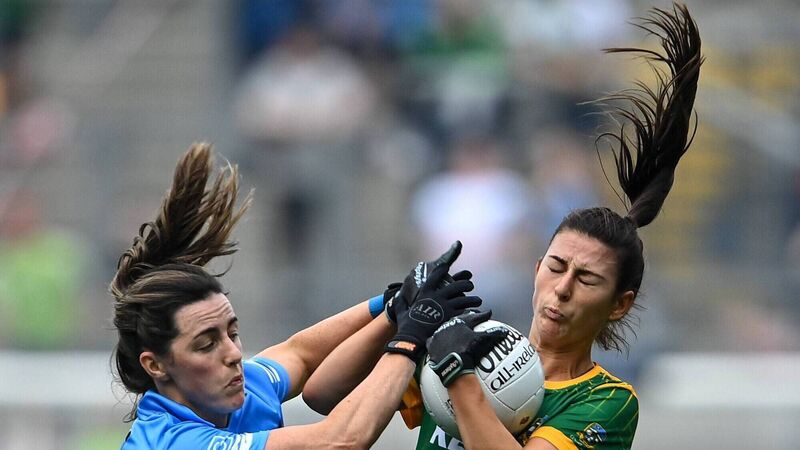Michael Moynihan: Population imbalance is the GAA's biggest issue

Meath's Emma Troy is tackled by Lyndsey Davey of Dublin during the All-Ireland final at Croke Park. Photo by Piaras Ó Mídheach/Sportsfile
A simple question this morning: What was the most significant development last week in the world of Gaelic games?
It depends on your perspective, of course. If you’re from Tyrone then the obvious retort is your county’s defeat of Kerry in the All-Ireland SFC semi-final; if you’re from Kerry then the repercussions within the county after the defeat are likely to be occupying you still.
Camogie fan? Then the results in the All-Ireland camogie semi-finals last week probably cast a long shadow/brightened the neighbourhood for you over the last seven days. Maybe Meath’s victory yesterday is on your radar.
If neither category fits you, then the managerial merry-go-round in intercounty hurling may be on your mind, Shane O’Neill deciding not to continue as Galway boss: Tipperary’s Darragh Egan taking over in Wexford.
Perhaps it’s your club’s opening salvo in the county championship, and what that game means within the parish, townland, or even your own home.
Or was it the news that came out of the Central Statistics Office last week?
Eoin English of this parish reported as follows: “Figures released by the Central Statistics Office (CSO) on Tuesday show how the combination of positive net migration and natural increase gave population growth of 34,000 in the year to April 2021 to push the population to an estimated 5.01m.”
There was a lot of chatter about breaking the 5m people barrier (and a good deal of scoffing at British media reports identifying the new total as the highest since the 1840s without giving any background to the particular events 180 or so years ago which led to the sharp decrease in numbers...)
But there was a good deal of other information in the press release, information that didn’t need a bland summary by overseas outlets to catch the eye.
According to the CSO website, for instance: “The Dublin region experienced weak growth in the year increasing its population by just 8,300 persons (+0.6%). Consequently, the population of Dublin in April 2021 was estimated to be 1.43m persons, equating to 28.5% of the total population.”
Consider this information in the context of Dublin’s departure from the All-Ireland SFC at the semi-final stage a couple of weeks ago.
Mayo’s win that day was greeted as the end of Dublin’s long supremacy, which may well prove to be true. More evidence might be accepted in the form of Offaly’s victory in the U20 All-Ireland series, which could be interpreted as a response from Leinster counties to the Dubs’ stranglehold on the province.
But demographics are hard to argue against, no matter how stubborn Dublin’s opponents are. One in four people in the country are in Dublin. Even allowing for the fact that not all those inhabitants of the capital are Dubliners, let alone paid-up GAA members, it’s a serious imbalance.
But that imbalance isn’t confined to the top level of Gaelic games. A friend of this column recently pointed out that in Cork, for instance, the club in one town with a population of almost 16,000, according to the 2016 census (Carrigaline), competes in the Carrigdhoun division with clubs drawing from areas such as Riverstick and Ballygarvan.
According to the same census figures, those clubs are drawing from constituencies of fewer than 600 people each.
The above is not designed to cast aspersions on the good people of Carrigaline in any way, but for this observer it raises a very obvious question.
If Dublin’s advantage in the numbers game is so marked, why is there relatively little fuss made about imbalances such as those in the Carrigdhoun division in Cork? Those imbalances occur all over the country and — to this observer — may be a more serious challenge to the good health of many counties than any notions of challenging Dublin in football or hurling.
Please stand for the anthem — If it’s on
The GAA’s move to get teams to respect the national anthem may have worked, or at least stopped a few lads scratching themselves or picking their noses — in which case it was a win-win — but matters are not quite as lighthearted in other jurisdictions.
In Texas, for instance, hundreds of laws were enacted last week on sensitive issues including abortion, race and teaching, and the right to carry a gun.
And a law on the national anthem and sport — namely the Star Spangled Banner Protection Act, which requires any professional sports team which receives state funding to play the national anthem before games.
One of the state’s professional teams, the Dallas Mavericks of the NBA, doesn’t play the national anthem before games and the new law is seen as a direct response to that decision.
It can also be seen as another front in the ongoing culture wars raging in the US between left and right, and on that basis there’ll be plenty readers who’ll roll their eyes and whisper ‘Yanks’ softly to themselves before moving on.
Can I point you towards comments from former GAA president Aogán Ó Fearghail, back in 2016?
“I was asked... would the GAA change its position at home regarding flying the flag and playing the anthem, I replied we wouldn’t, that it was very much part and parcel of our culture, it was very much valued by us and that it was a key part of our heritage and it will remain.
“I did offer the opinion that who knows what may happen in the future. We all aspire to, certainly within the GAA, to a new unified Ireland, it is something that we would welcome, it is something that we would be very happy to see happening.
“In those new political realities which hopefully will happen, who knows what may happen in the future?
“That was very much in the realms of speculation as to a new future.”
But Texas, eh?
What the future looks like
Kudos to the Dublin national school which made a simple but significant step towards real equality during the week.
I note that St John the Baptist Junior Boys’ School was calling on all boys to wear sky blue to support the Dublin team in an All-Ireland senior final last weekend — the Dublin ladies footballers.
This is the kind of initiative that does more than a thousand strategies, planting as it does in small minds the most obvious notion of all — that a county team in an All-Ireland final is something to celebrate, the gender of those involved being beside the point.
By getting boys to fly the flag and wear the colours establishes this as established practice with no further ado, and is precisely what is needed to help build a real sense of equality in sport.
Sally Rooney. Another omen.
Only one book being discussed this week by everyone, I notice. Yes, even in my eyrie I have clocked the fact that Sally Rooney’s new book is the subject of much fevered discussion.
Is there an augury for her county of Mayo in the publication of Beautiful World, Where Are You this week? They play Tyrone in an All-Ireland final this Saturday.
What does it mean that a Mayo person has already won an All-Ireland title (of sorts) this week? What does it mean?
- Contact: michael.moynihan@examiner.ie

Unlimited access. Half the price.
Try unlimited access from only €1.50 a week
Already a subscriber? Sign in










